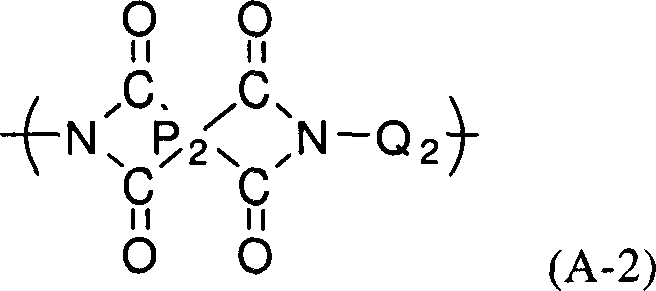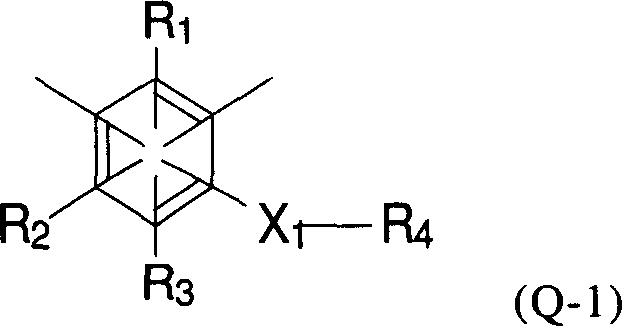Polyimide resin polymer and liquid crystal alignment layer material containing the same
A polyimide resin and polymer technology, which is applied in the fields of instruments, optics, nonlinear optics, etc., can solve the problems of high addition ratio, limited use, and increased production costs.
- Summary
- Abstract
- Description
- Claims
- Application Information
AI Technical Summary
Problems solved by technology
Method used
Image
Examples
Embodiment 1
[0076] 1.34 grams (0.0025 moles) of 3,5-diamino-2-methylbenzoic acid cholesteryl ester, 5.13 grams (0.0475 moles) of p-phenylenediamine (PPDA), 1.94 grams (0.01 moles) of 1,2,4,5- Phthalic anhydride (PMDA), 8.1 grams (0.03 moles) of 3,3',4,4'-diphenyl dianhydride (BPDA) and 1.96 grams (0.01 moles) of cyclobutane tetracarboxylic dianhydride (CBDA), and After reacting 61.3 g of N-methyl-2-pyrrolone (NMP) at room temperature for 8-16 hours, add 326.9 g of NMP to dilute it to obtain a polyamic acid solution with a reduced viscosity of 0.2 dl / g. This solution is spin-coated on a glass substrate with a transparent electrode at 3000rpm, and heated at 200°C for 30 minutes to form a polyimide resin film. After cooling, it is assembled into a mutual Parallel direction liquid crystal cell, after pouring liquid crystal (model: ZLI-4792, manufactured by Merck), this element rotates between crossed Nicol crystals (crossed nicol), and presents a fully dark state, using the pretilt angle The...
Embodiment 2
[0078] 2.69 grams (0.005 moles) of 3,5-diamino-2-methylbenzoic acid cholesteryl ester, 4.94 grams (0.045 moles) of p-phenylenediamine, 0.97 grams (0.005 moles) of 1,2,4,5-phthalic anhydride , 8.1 grams (0.03 mole) 3,3 ', 4,4'-diphenyl dianhydride and 2.58 grams (0.015 mole) cyclobutane tetracarboxylic dianhydride, and 21.9 grams of N-methyl-2-pyrrolone ( NMP) reacted at room temperature for 4-12 hours, then added 73.1 g of NMP to dilute it to obtain a polyamic acid solution with a reduced viscosity of 0.8 dl / g. This solution is spin-coated on a glass substrate with a transparent electrode at 3000rpm, and heated at 200°C for 30 minutes to form a polyimide resin film. After cooling, it is assembled into a mutual Parallel direction liquid crystal cell, after pouring liquid crystal (model: ZLI-4792, manufactured by Merck), this element rotates between crossed Nicol crystals (crossed nicol), and presents a fully dark state, using the pretilt angle A measuring machine (Tilt Angle T...
Embodiment 3
[0080] 2.14 grams (0.004 moles) of 3,5-diamino-2-methylbenzoic acid cholesteryl ester, 1.72 grams (0.016 moles) of p-phenylenediamine, 1.55 grams (0.008 moles) of 1,2,4,5-phthalic anhydride and 3.24 grams (0.012 moles) of 3,3',4,4'-diphenyl dianhydride, and 24.4 grams of N-methyl-2-pyrrolidone (NMP) reacted at room temperature for 8 to 12 hours, then added Dilute it with 83.9 grams of NMP to obtain a polyamic acid solution with a reduced viscosity of 0.4dl / g. This solution is spin-coated on a glass substrate with a transparent electrode at 3000 rpm, and heated at 200°C for 30 minutes to form a polyimide resin film, which is assembled into a After filling the liquid crystal cell in parallel directions (model: ZLI-4792, manufactured by Merck), the element rotates between crossed Nicol crystals (crossed nicol) and presents a fully dark state. The value of the pretilt angle obtained by the Tilt Angle Tester (TBA) is 90.
PUM
| Property | Measurement | Unit |
|---|---|---|
| Reduced viscosity | aaaaa | aaaaa |
| Reduced viscosity | aaaaa | aaaaa |
| Reduced viscosity | aaaaa | aaaaa |
Abstract
Description
Claims
Application Information
 Login to view more
Login to view more - R&D Engineer
- R&D Manager
- IP Professional
- Industry Leading Data Capabilities
- Powerful AI technology
- Patent DNA Extraction
Browse by: Latest US Patents, China's latest patents, Technical Efficacy Thesaurus, Application Domain, Technology Topic.
© 2024 PatSnap. All rights reserved.Legal|Privacy policy|Modern Slavery Act Transparency Statement|Sitemap



